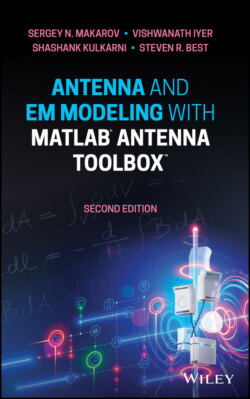Читать книгу Antenna and EM Modeling with MATLAB Antenna Toolbox - Sergey N. Makarov - Страница 14
1.1 ANTENNA CIRCUIT MODEL. ANTENNA LOSS
ОглавлениеThe generic transmitter (TX) circuit with an antenna is shown in Figure 1.1. The generator (g) is modeled as an ideal (sinusoidal or pulse) voltage source Vg in series with the generator resistance Rg, connected to a TX antenna. The typical generator resistance is 50 Ω. This model is known as Thévenin equivalent of the generator circuit. The Norton equivalent may also be used when necessary.
Figure 1.1 A generator (its Thévenin equivalent) connected to an antenna.
The portion depicted in the shaded box is an antenna. The antenna in Figure 1.1 is assumed to be resonant, which means that its equivalent impedance, Za, is purely real, i.e.
(1.1)
In order words, the resonant antenna is simply modeled by a resistor Ra.
The antenna resistance Ra includes two parts:
1 Radiation resistance of the antenna Rr that describes the circuit power loss due to radiation by the antenna into free space.
2 Loss resistance of the antenna RL that describes the circuit power loss in the antenna itself. Case in point: a long thin wire with a significant ohmic resistance or a helical antenna with a ferrite lossy core.
One thus has
(1.2)
Parasitic antenna resistance RL has the following features:
1 it is zero for ideal antennas (a metal antenna made of perfect electric conductors);
2 it is usually relatively small for metal antennas covering the band 0.3–3 GHz (UHF, L‐band, S‐band) where it may be often ignored;
3 it may be very significant for printed antennas on lossy dielectric substrates and in the vicinity of lossy dielectric (such as FR4, ABS, human body, etc.);
4 it is vital for very small antennas whose size is much less than the wavelength.
